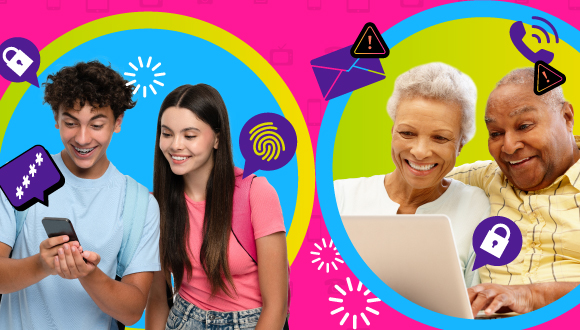By John Hewie, National Security Officer, Microsoft Canada
For this blog post, Get Cyber Safe has partnered with Microsoft, who, like us, understands how important cyber security is to businesses as well as individuals. This blog presents their perspective, and we thank them for being a dedicated partner in the cyber security of Canadians.

When it comes to cyber security issues like phishing, malware, tech support fraud and other threats, they are sometimes viewed through a generational lens. While fraud is the number one reported crime against older CanadiansFootnote 1, data shows that online risks affect everyone. Recent research highlights a growing vulnerability in younger generations too. Nearly 60% of Gen Z have faced cyber attacks through social media, texts or emailFootnote 2, making it clear that cyber criminals tailor their strategies based on behaviour, as well as age.
A combined approach—one that balances caution, vigilance and technical know-how—can help build resilience and strengthen our overall security posture.
Why cyber security is not a one-size-fits-all solution
Each generation faces different risks due to their online behaviours and familiarity with technology:
- Older Canadians can be victims of phone scams, phishing, technical support fraud and identity theft because of their unfamiliarity with newer digital platforms and services
- Gen Z and millennials, despite being tech savvy, are sometimes more susceptible to social engineering attacks that exploit their personal information because of sharing content online
Everyone brings unique strengths to cyber security. Younger generations tend to be more tech savvy and adept at navigating security settings, while older generations may be more patient and skeptical, which can help in identifying scams. Here's how Canadians can support each other in staying more secure.
- Younger generations can share:
- setting up strong authentication measures like multi-factor authentication (MFA)
- using password managers to protect complex and unique credentials
- navigating security and privacy settings on digital devices and social media
- Older generations can share:
- learning how to recognize suspicious emails or phone calls
- being cautious when responding to unexpected requests
- asking a family member or friend for help if needed
This mutual exchange of information not only enhances individual security but also builds a culture of cyber safety that spans generations.
At Microsoft, we recognize our unique responsibility in safeguarding the future for our customers and communities and are prioritizing security above all else. We recently developed the Be Cybersmart Kit (PDF), a resource designed to help educate people and organizations on best practices for going passwordless, not falling for sophisticated phishing or fraud, device protection, AI safety, and more.
Practical tips for staying safe online
To bridge the gap and protect all generations, here are some key cyber security practices that everyone should implement:
Secure your accounts with MFA
MFA adds an additional layer of security by requiring users to verify their identity through multiple sources. This is particularly effective at preventing account takeovers. Microsoft offers a free authenticator app that makes it easy to set up and use MFA, providing an added level of protection for all age groups.
Use strong and unique passwords
Create passwords that mix letters, numbers and symbols. Avoid using the same password across different accounts. Instead, consider a password manager to generate and store strong, unique passwords for each account. Learn more about password managers and how to choose the best one for you.
Be wary of unexpected messages
Whether it's an email from your bank or a text from an unknown number, take a moment to verify the sender. Look out for unexpected messages containing urgent language, requests for information or too-good-to-be-true offers as signs of phishing.
Keep your software updated
Keeping software updated is crucial for closing security gaps. Use automatic update features to ensure you have the latest security patches.
Review privacy settings regularly
Protect your sensitive information by setting your social media profiles to limit the amount of personal information you share publicly. Adjust your privacy settings regularly, as platforms update their privacy policies. Use tools like Microsoft privacy dashboard to manage and control what information is shared across platforms.
Back up your data
Regularly back up critical files to a secure location, such as an encrypted cloud service. This is essential in preventing data loss from ransomware attacks. Options like OneDrive's Backup Feature provide secure and encrypted storage for important files, with easy access in case of emergency.
Building a cyber-secure future together
Cyber security is a shared responsibility. Families can make online safety a regular topic of conversation, workplaces can offer training, and community groups can facilitate peer learning sessions that considers generational differences. A proactive and collective approach will build resilience and foster a culture of security that is inclusive and effective.
Creating this shared security culture isn't just about adopting the latest technology—it's about fostering a mindset of vigilance, curiosity and continuous learning. Making cyber security education a lifelong pursuit will build lasting resilience.
Bridging the cyber gap
Every generation has unique strengths and blind spots when it comes to cyber security. By learning from each other and using modern security tools, it's possible to create a safer digital world for all. Whether it's a senior learning how to spot phishing scams or a Gen Z teaching their parents about MFA, every conversation about online safety brings Canadians closer to building a cyber-resilient society.
The bottom line: cyber security is not just about protecting yourself—it's about protecting those around you. When we come together, share our knowledge and use the right tools, everyone can stay safe and secure in an ever-evolving digital landscape.